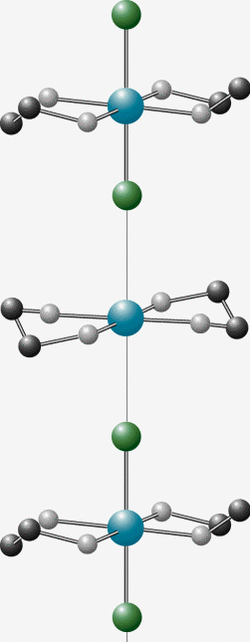Atoms Caught Moving Fast

Like high-tech spies, condensed matter physicists sometimes try to record the private motions of atoms. Often this has meant measuring their high frequency vibrations in solids, but now a team reports in the 8 May PRL that they have caught atoms in the act of moving to a new structure at high speed. The structural change the authors observed–which occurs in a few hundred femtoseconds ($10^{-15} seconds)–is related to the process of charge conduction in an emerging class of materials for electronic devices. So the work may lead to hints about how these materials work at the most basic level, while providing a technique for getting a more detailed look at how atoms rearrange.
Traditionally the motion of electrons in solids is described with so-called Bloch waves–quantum states that extend spatially throughout an entire crystal. But charge can also be carried in localized bunches, a more complicated process that can be the dominant one in the conduction properties of materials used in some electronic devices and in materials being developed for future devices, according to Susan Dexheimer of Washington State University in Pullman.
To learn more about the localization process, Dexheimer and her colleagues set out to observe the formation of a “self-trapped exciton”–a localized electron-hole pair that forms in a type of linear chain molecule following absorption of a laser photon. Since excited electrons can create and respond to atomic motions (phonons) in this material, the exciton generates a distortion of the normal bond lengths in its neighborhood, while at the same time, the distortion helps to localize the exciton. It becomes “self-trapped” and can survive for many picoseconds. The team managed to record these fast atomic rearrangements during the exciton formation–the first time this process was clearly observed.
The researchers used a crystal of an inorganic polymer with alternating platinum and bromine ions on the main backbone. Employing 35 fs laser pulses to both “pump” (create excitons) and “probe” the crystal, they determined changes in the sample’s optical properties as a function of time following the pump pulse. Because of the strong electron-phonon interaction, the sample’s optical response oscillated and decayed in time, as the ions “rung like a bell” at several frequencies in response to the pump. After accounting for previously known ion vibrations, the team was left with a single oscillation with a period of 200-300 fs that decayed after one or two oscillation cycles. By probing at several wavelengths of light, they identified this signal as the signature of the change in local structure associated with the creation of a self-trapped exciton.
“What’s remarkable,” says Dexheimer, “is that the formation time is comparable to the lattice vibrational period,” about as fast a process of structural rearrangement as could possibly exist. Keith Nelson of MIT says the measurements “largely complete the picture” of how localized excitons form in this type of material, and the phenomena “are likely to be common to a wide variety” of materials, including many types of semiconductors.


